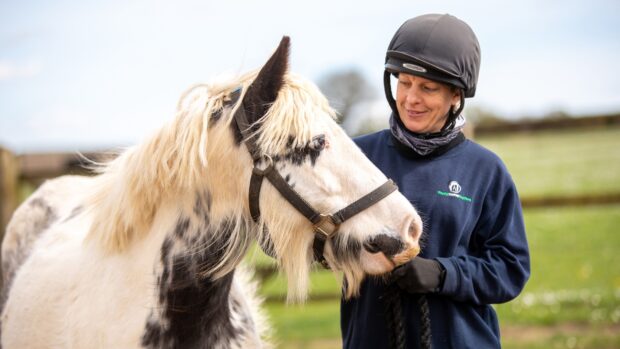Taking horses’ temperatures can save lives – and has done so – riders have been reminded, as the community unites to fight the threat of strangles.
To mark the 2023 Strangles Awareness Week (1–7 May), World Horse Welfare presented a webinar titled “Take the heat out of strangles”, on 3 May.
Experts spoke about the latest developments in biosecurity, best practice in preventing strangles and managing outbreaks when they do occur. Equestrians were reminded that it is the most commonly diagnosed infectious equine disease in the UK, and that a high temperature is often the first sign, typically two to three days before the horse starts shedding the infection.
FEI senior veterinary advisor Caterina Termine spoke about the importance of good biosecurity for all equine infectious diseases, referring to the “devastating” EHV outbreak in Europe in 2021.
She explained new rules brought in as a result of this, including twice-daily temperature checks of horses before and during competition, all recorded on the FEI app, and vet checks at shows.
“Temperature taking has been a game-changer,” she said, adding that if any horse records a temperature of above 38.5°C, it is immediately isolated, “which is absolutely crucial in terms of stopping potential transmission”.
The horse is then rested, as “rest is the most important thing you can do”, Dr Termine said, and any in-contact horses are identified. She added that when cases were recorded in Oliva this spring, only 28 horses tested positive, as opposed to 118 in 2021, and none died, as opposed to 18.
“Temperature taking has saved lives,” she said. “It’s meant we can act faster to save horses.”
Dr Termine urged equestrians to take their horses’ temperatures as part of their daily routine, as it can be the earliest warning of any issues, which was reiterated in a panel discussion.
Abigail Turnbull of Richmond Equestrian Centre, which had to cancel competition owing to a strangles outbreak in 2019, said the livery yard was managed on a traffic light system; the red area contained suspected and confirmed cases, amber was for those who may have had contact with “red” horses, and green for those who had no signs and had had no contact.
“I had charts and every owner texted me their horse’s temperature twice a day,” she said. “It’s a two-minute job and it will pick things up.”
Richmond’s biosecurity measures are now included in its livery contract, and all owners and visiting professionals have to take the Redwings “Stamp out strangles” pledge.
Para dressage rider Fiona Maynard, who has had a strangles outbreak this spring after a carrier horse came in for training, said it has been “financially and emotionally very stressful”. Her biosecurity measures have included different people working on different yards to minimise transmission, and she has been looking into measures such as separate stabling for visiting horses in future.
“I’m so nervous now,” she said. “Good biosecurity keeps everyone safe.”
Vet Katie Kelly, who has recently dealt with strangles, said identifying the disease early is key in minimising spread and the length of outbreaks, as is good biosecurity and being honest and transparent with others. Owners were reminded that horses can show no signs but go on to be strangles carriers for long periods, so ongoing testing and treatment if needed until all are given the all-clear is key.
You might also be interested in:

Yard where four ponies died in ‘devastating’ strangles outbreak speaks out to save others

‘It won’t work if it stays on the shelf’: vets report ‘limited uptake’ of new strangles vaccine

Strangles: the latest research on the disease and what you need to know *H&H VIP*
Until the highly contagious disease strangles is eradicated, early identification and immediate isolation remain key to containing outbreaks. Karen Coumbe
Horse & Hound magazine, out every Thursday, is packed with all the latest news and reports, as well as interviews, specials, nostalgia, vet and training advice. Find how you can enjoy the magazine delivered to your door every week, plus options to upgrade your subscription to access our online service that brings you breaking news and reports as well as other benefits.





